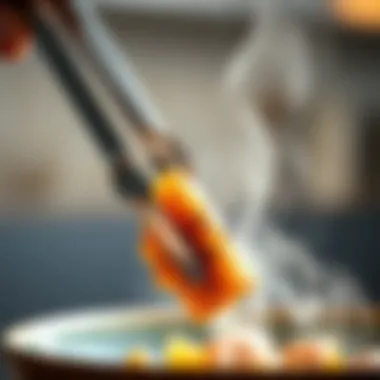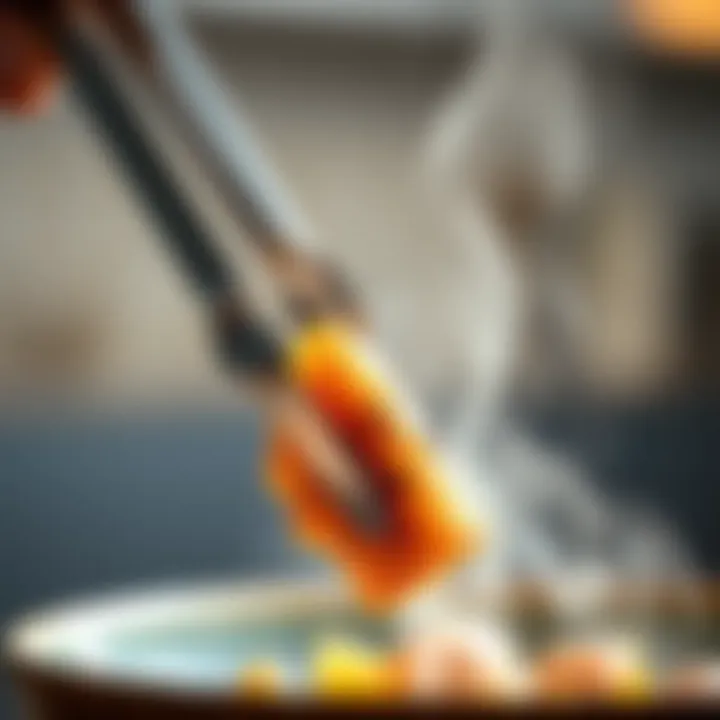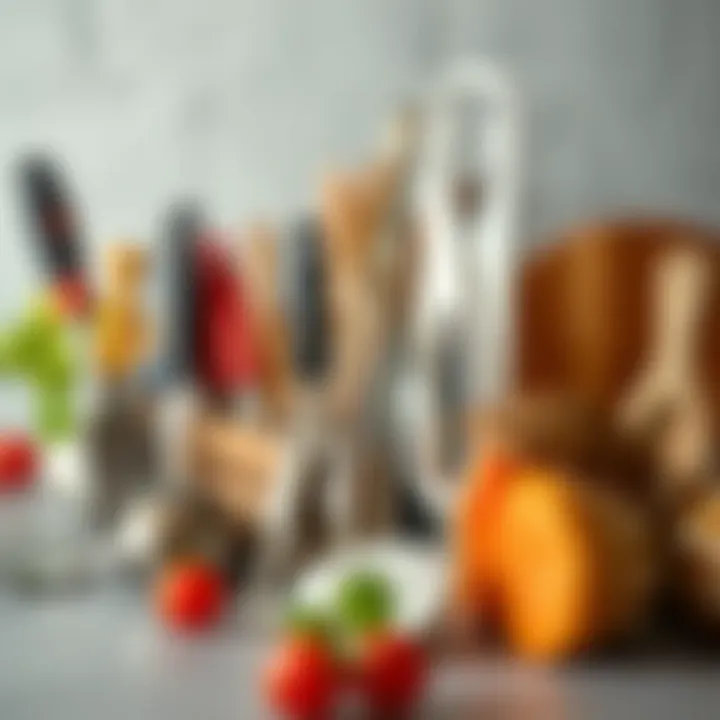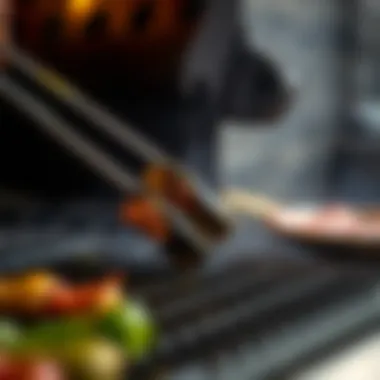The Versatile Design and Benefits of Long Skinny Tongs


Intro
When stepping into the realm of culinary tools, long skinny tongs often do not get the spotlight they deserve. These seemingly simple instruments have an undeniable impact, making them essential for chefs and home cooks alike. The design of long skinny tongs speaks to their utility. They provide precision in handling foods without compromising on safety or efficiency. From flipping a delicate piece of fish to retrieving sizzling vegetables from a hot grill, the uses extend far beyond what might be expected.
The construction of these tongs, typically crafted from stainless steel or silicone, enhances their durability and resistance to heat. Their slim profile enables you to reach deep into pots or grills, maneuvering food with finesse. They can also be used in baking, serving a distinct purpose in both savory and sweet endeavors.
Why Focus on Long Skinny Tongs?
In a world where kitchen gadgets often accumulate dust, long skinny tongs hold their ground in practicality. Consider this: have you ever tried to flip thin bacon strips with a wide spatula? Just about impossible, right? The right set of tongs provides flexibility as well as control, catering to various cooking techniques. Understanding their design, utility, and advantages can elevate your culinary skills significantly.
Prelude to Long Skinny Tongs
Understanding the significance of long skinny tongs is essential for both culinary enthusiasts and home cooks. These versatile tools not only aid in cooking but also elevate the entire experience in the kitchen. With their unique design, they're crafted to help grasp, flip, and serve food with precision and ease. The importance of these tongs extends beyond utility; they embody the intersection of culinary art and practical design, enhancing efficiency during food preparation.
Long skinny tongs serve distinct roles depending on their context—be it grilling, baking, or serving. They help manage delicate ingredients without crushing them, making them indispensable when handling items like asparagus or grilled vegetables. Plus, their slender profile allows you to maneuver in tight spaces, which can be a lifesaver in a busy kitchen.
When we delve deeper into this topic, we’ll explore how various design elements contribute to their effectiveness. Also, understanding what makes each pair of tongs suitable for specific tasks will enable cooks to select the right tool that complements their culinary methods. It's also worth noting that the materials used and ergonomic features play a crucial role in comfort and longevity, ensuring that they remain in your cooking arsenal for years.
As we begin our exploration, it’s essential to grasp the basics—what exactly are long skinny tongs and how did they evolve over time? Let's unfold this culinary tool’s journey.
What Are Long Skinny Tongs?
Long skinny tongs are specialized kitchen tools designed for gripping and manipulating food items with precision. Typically made of materials such as stainless steel, these tongs have a slender structure that allows for a firm grip and increased control. They often feature a locking mechanism for easy storage and varied functionalities, depending on the culinary tasks at hand.
Their elongated design provides an advantage in reaching deeper pots and pans, especially when cooking on the stove or at the grill. Long skinny tongs are commonly used to handle food that requires a delicate touch, such as flipping fillets of fish or serving up individual portions of salad.
Also, variants exist that include silicone tips to protect cookware surfaces, catering directly to the needs of home cooks aiming for both functionality and care for their kitchen tools. Different lengths and widths of tongs suit specific tasks, helping to ensure that even the most intricate dishes are handled safely and effectively.
Historical Context
As with many kitchen utensils, long skinny tongs have a rich history that reflects evolving culinary needs and practices. Their roots can be traced back to ancient times, where simple versions were utilized for handling food over open flames. Early iterations may have been crafted from wood or animal bones, focusing on practicality and availability of materials.
As culinary techniques advanced, so did the design of tongs. By the Middle Ages, metalworking innovations allowed for more sophisticated tools. Metallic tongs were forged to withstand heat and offer better grip and sturdiness, marking a significant shift in design.
Fast forward to modern times, where ergonomics and material science have come into play. Today, we see a plethora of designs, with variations made from stainless steel, silicone, or composite materials that enhance both durability and usability. The versatility of long skinny tongs makes them a staple in both amateur and professional kitchens alike, proving their timeless value in food preparation through the generations.
The ever-evolving nature of kitchen tools, including long skinny tongs, highlights how culinary practices intertwine with technology and lifestyle changes, showcasing the importance of adapting to different cooking techniques and preferences. In this context, it’s fascinating to see how they continue to be integral in various culinary environments, from home kitchens to high-end restaurants.
Design Features of Long Skinny Tongs
The design of long skinny tongs stands as a testament to the interplay between functionality and form. These utensils aren’t just tools; they reflect a careful balance of aesthetics and practical solutions to everyday cooking challenges. A close look at their design features reveals elements that, while seemingly simple, carry significant weight in enhancing the culinary experience.
Material Considerations
Stainless Steel
When we think of kitchen implements, stainless steel often comes to mind as a first-rate material. Strong and rigid, this metal is renowned for its durability and corrosion resistance. Its resistance to rust serves as a strong ally when cooking in humid or watery conditions, which is common in kitchens. This means less fret about wear and above all, longevity.
One noteworthy trait of stainless steel tongs is the ease with which they can be cleaned. Unlike other materials that may absorb odors or stains, stainless steel remains pristine after a quick wash. However, these tongs can sometimes be slippery, demanding careful handling, especially when maneuvering around delicate items.
Silicone Tips
The introduction of silicone tips to long skinny tongs marks a significant revolution in kitchen technology. Silicone is heat-resistant, making it perfect for flipping meats on a grill or serving high-temperature dishes without the fear of melting or warping. This additional feature caters to home cooks who value versatility.


Silicone tips grip food sturdy yet gently. They prevent scratching non-stick pans, ensuring that the integrity of your cookware remains intact. However, as beneficial as they are, silicone tips may exhibit wear over time, particularly if they are not cared for properly. This aspect is worth considering for those who wish to keep their tongs operating optimally.
Wood Alternatives
Wood alternatives serve as a charming addition to the world of tongs with their own flair. Eco-friendly and often artisanal in appearance, wooden tongs embody a sense of rustic sophistication. They offer a certain warmth, making them appealing to many home cooks who cherish the tradition of using wooden tools in their kitchen.
One primary advantage of wood is that it doesn’t conduct heat. This means you can comfortably handle hot foods without worrying about burning your hands. However, it’s essential to note that wooden tongs might absorb moisture and oils over time, leading to potential bacteria growth if not cleaned properly. This calls for care in maintenance but there is something unique about the wood's character, making it a delightful addition to any kitchen.
Ergonomic Design
Grip Comfort
Grip comfort is essential when considering the functionality of long skinny tongs. The best designs ensure a comfortable hold, allowing for extended use without straining your hands. Tongs with textured grips or contoured handles enhance the user experience, permitting more control over movements, whether you are flipping a steak or picking up a delicate pastry.
A comfortable grip means less hand fatigue, which translates to better control during intricate tasks. However, if the grip is poorly designed or lacks sufficient padding or texture, it can lead to slips and mishaps in the heat of cooking. This aspect of design is something that can’t be overlooked.
Weight Balance
The weight balance of tongs is pivotal for efficiency. A well-balanced pair allows for smooth maneuverability, making every action feel natural, especially when you need to keep one hand free for other tasks. This balanced state contributes to precision while cooking, aiding in actions such as flipping chicken on the grill or elegantly plating a dish.
While some may prefer lightweight tongs for ease of handling, heavier tongs can often provide a sense of sturdiness that instills confidence while flipping or grasping. Weighing all options comes down to personal preference, but balance is key.
Length Specifications
Length is another critical factor to mull over. Length specifications influence not only the reach of tongs but also their overall effectiveness. Longer tongs are often beneficial when grilling, allowing the user to stay at a safe distance from flames, while shorter ones might provide better control during delicate cooking situations like plating.
The right length increases reach, ensuring you can access all corners of your cooking vessels without fear. Yet, if the length is too great, it may reduce user control over food items. Finding that sweet spot is vital for ensuring that the tongs can perform their duties without hurdles.
Functionality of Long Skinny Tongs
When it comes to culinary tools, functionality stands as the backbone of any effective kitchen operation. Long skinny tongs shine in this respect, offering unique capabilities that not only streamline food handling but also enhance precision in culinary tasks. With their slender design, these tongs are not just a mere extension of a cook's hand. They act as an instrument of control, especially when managing a variety of tasks, from turning meats on the grill to delicately plating appetizers. The balance between usability and effectiveness makes them essential for both amateurs and seasoned chefs alike.
Versatility in the Kitchen
The fact that long skinny tongs can adapt to various kitchen tasks makes them a tool of choice for many. Rather than being limited to a specific purpose, the versatility within their design allows for a broad range of applications.
Grilling Applications
Grilling, a quintessential cooking method, requires tools that can withstand high temperatures and deliver control over food items. Long skinny tongs excel here. Their design permits a firm grip without applying unnecessary pressure, which is vital when dealing with delicate grilled vegetables or meats. One major characteristic of these tongs is their slenderness, allowing users to maneuver into tight spots on the grill where spatulas may be too bulky.
The advantage of using long skinny tongs for grilling is clear: they help flip or move items without losing their form or seasoning. However, keep in mind that tongs with a more pronounced grip can sometimes leave marks on sensitive food items, so selecting the right pair is key.
Serving and Plating
When it comes to the final touches in food presentation, long skinny tongs are invaluable. Their design allows for precision in serving, whether it's placing a single piece of sushi on a plate or elegantly arranging garnishes atop a dish. The prominent feature here is their ability to offer a gentle yet secure grasp on items, which is especially useful for delicate presentations.
Using these tongs for serving also minimizes mess, as they are designed to minimize the risk of dropping or spilling food. Nevertheless, one must consider the material of the tongs, as metal tips may not be suitable for all types of plates and bowls, particularly those made of ceramics or glass.
Unique Baking Uses
While baking may not be a common notion when one thinks of tongs, long skinny tongs can play an unexpected role in this area. They come in handy for tasks like retrieving delicate cookies from a cooling rack or rearranging pastries without compromising their structure. One standout quality of tongs in baking is their reach and ability to pick up items that are light yet fragile, where simply using hands would lead to disaster.
However, one should exercise caution while using tongs on freshly baked goods. Their grip can accidentally deform soft shapes if not used skillfully. Overall, the manifold baked applications of these tongs have earned them a respectable place within the baking community.
Precision and Control


While versatility provides breadth, precision offers depth, allowing cooks to engage in various tasks with confidence. Long skinny tongs are particularly designed for precision, thereby equipping chefs to handle challenges effortlessly.
Handling Delicate Ingredients
There are certain ingredients in any kitchen that demand a gentle touch, like soft cheeses or perfectly poached eggs. Long skinny tongs stand out for their careful grip, which ensures fragile items are picked up without damage. The essence of this kind of functionality is the ability to navigate through textures without compromising integrity.
Being lightweight yet robust gives these tongs a further edge, allowing quick movements with minimal effort. However, one must weigh the choice of tongs as they may vary in width; a broader end might not suit some delicate tasks.
Avoiding Spills
The precision of long skinny tongs contributes significantly to minimizing spills during food transfers. When handling sauces or ingredients that may wreak havoc on a counter, these tongs allow for secure lifts and easy maneuvering. Their design enables users to grasp and tilt items efficiently, making them a smart choice for busy environments.
However, depending on the size of the ingredient, it’s crucial to ensure a comfortable fit with the tongs to prevent accidents. Poor alignment can lead to mishaps, but when used correctly, the outcome can improve the overall cooking experience.
Efficient Turnover of Food
Efficiency, especially in a busy cooking environment, is crucial. Long skinny tongs help chefs turn over food items swiftly, aiding in proper cooking times. The unique feature of their design allows for easy flipping of items like pancakes or meats, ensuring an even cook. Touching the food with minimal effort can also keep the heat contained, preventing unnecessary energy loss.
While their efficiency is a major advantage, users must be aware that not all tongs come with equal gripping power; ensuring that you have a high-quality pair becomes essential for maintaining efficiency.
The design and function of long skinny tongs bring unparalleled utility to the kitchen, enabling users to excel in various cooking endeavors.
Choosing the Right Long Skinny Tongs
When diving into the world of long skinny tongs, it becomes essential to recognize that not all tongs are created equal. The right pair can transform how you cook, making the difference between a successful culinary task and a messy disaster. This section emphasizes the key aspects to consider when selecting long skinny tongs, helping you make informed choices that suit your specific needs.
Size Matters
Choosing Length Based on Task
The length of your tongs can significantly influence your cooking experience. If you’re dealing with a grill, longer tongs, often around 12 to 16 inches, prove beneficial. These extended lengths keep your hands away from flames while offering optimal control. Conversely, if you’re baking and lifting delicate cookies off a sheet, shorter tongs, maybe about 8 to 10 inches, are easier to manipulate without risking a breakage.
Optimal length isn’t just about safety; it’s also about reach and precision. A key characteristic when selecting the length based on task is the ability to maneuver food seamlessly. Longer tongs allow for better distance management, while shorter ones can enhance your ability to handle small or fragile items with care.
The unique feature here lies in finding a balance; if tongs are too long, they might lack the finesse needed for finer work, while those too short could leave you at risk of burns or burns from the heat. This adaptability makes choosing the right length a top priority in this article.
Storage Considerations
Consideration of storage space for your tongs is often overlooked but can be equally important. Long skinny tongs can sometimes be a nuisance if you have limited drawer space. A key characteristic of effective storage is that they are neatly organized and readily accessible. Many options now come with hanging loops or built-in magnets which can make your kitchen more efficient and less cluttered.
Additionally, the material of the tongs may play a role in how and where they can be stored. For instance, wooden or silicone-tipped tongs might be better kept in a drawer while stainless steel can be more robust for hook-style storage. A well-designed storage option can enhance the ease of access while ensuring your tongs don’t become damaged.
Evaluating Price and Quality
When choosing long skinny tongs, it’s vital to evaluate the interplay between cost and durability. Not all that glitters is gold, and while a high price might suggest superior quality, it’s essential to look deeper than the label.
Cost vs. Durability
Cost vs. durability is a balancing act that many cooks encounter. While it’s tempting to opt for cheaper models, they may not withstand the rigors of continuous use. A quality pair of tongs might carry a higher upfront cost, yet they often prove to be worth their weight in gold over time.
The key idea here is that investing in robust and lasting tongs can save you money in the long run. Spirited cooks know that a quality pair of tongs can elevate their culinary experience, offering hands-on versatility and durability. It’s worth examining brand reviews and materials to ensure you’re making a sound investment.
Brand Reputation
Brand reputation plays a significant role in the purchase decision as well. Some brands have carved out niches for quality kitchen tools, while others may be better known for flashy marketing over substance. A well-recognized brand might offer reassurance about the quality and workmanship of their products. It often reflects customer satisfaction, history, and expertise.


When evaluating brand reputation, look for feedback on durability, user experience, and customer service. It’s often beneficial to seek out recommendations from culinary communities or forums. This way, you can glean insights from those who’ve already made the leap. Overall, brand reputation can act as a handy barometer, guiding you towards reliable options in a sea of choices.
Maintenance and Care of Long Skinny Tongs
Keeping your long skinny tongs in peak condition is critical for both performance and longevity. Proper maintenance not only ensures that the tongs are effective for various culinary tasks but also extends their lifespan, which ultimately saves money and enhances your cooking experience. Just like any essential kitchen tool, tongs require a bit of attention to detail.
Cleaning Techniques
Hand Washing Best Practices
When it comes to cleaning long skinny tongs, hand washing remains the gold standard. This method allows for careful inspection of every nook and cranny of the tongs. Begin by using warm, soapy water and a soft sponge, paying close attention to any food residues that may hide in the hinges or crevices.
One key characteristic of hand washing is its ability to maintain the integrity of the tongs’ materials. For instance, high-quality stainless steel can withstand scrubbing without risk of damage, while silicone tips may require a gentler touch. This care is particularly crucial in maintaining the grip and non-stick properties of the tips, ensuring they remain effective for delicate tasks, like flipping thin crepes or serving intricate pastries.
Moreover, hand washing allows you to avoid the harsh detergents and high temperatures often found in a dishwasher, which can degrade certain materials over time.
"Taking the time to hand wash your tongs can greatly reduce the risk of wear and tear, ensuring they last through many meals and gatherings."
Dishwasher Compatibility
On the flip side, some long skinny tongs boast dishwasher compatibility, which can be a real timesaver for busy home cooks. If you choose to rely on this method, it's essential to check the manufacturer's instructions. Many brands indicate whether their products can withstand the high heat and strong detergents of a dishwasher.
The appealing aspect of dishwasher compatibility is that it simplifies the cleanup process. Simply place the tongs in the cutlery basket, and you're off to your next task. However, be mindful, as prolonged exposure to the intense environment of a dishwasher can lead to wear on any plastic or silicone components. Select tongs designed specifically for dishwasher use to ensure they don't warp or lose their shape during cycles.
Longevity Tips
Preventing Rust
Rust can be the bane of any metal utensil, and long skinny tongs can be vulnerable if not cared for appropriately. To prevent rust from forming, it’s beneficial to dry your tongs immediately after washing. Water spots can quickly turn into rust if tongs are left damp, especially if they're made of carbon steel.
The ideal practice is to wipe down the tongs with a soft cloth after washing. This not only helps to ensure they remain dry but also gives you a chance to spot any issues before they worsen. Regular oiling can be an extra safeguard, using food-safe mineral oil to create a protective layer.
Monitor Wear and Tear
Routine checks for wear and tear can go a long way in ensuring the tongs remain safe and effective in the kitchen. Things to look out for include loose joints, fraying silicone tips, or scratches on the surface of stainless steel.
Addressing these issues early on can prevent bigger problems later, such as broken tongs during crucial cooking moments. Additionally, it's wise to replace tongs that are showing signs of significant wear, as maintaining a tool that can't perform properly can lead to kitchen mishaps. Keeping a close eye on these aspects allows for uninterrupted culinary adventures.
Adopting these simple maintenance and care techniques will help you enjoy the full benefits of your long skinny tongs for years to come, making every cooking session smoother and more enjoyable.
End
In wrapping up our exploration, it’s evident that long skinny tongs are far from just a simple kitchen tool; they hold considerable significance in the culinary world. Their unique design and functionality cater to a variety of cooking requirements, making them indispensable for many chefs and home cooks alike. The importance of understanding how to choose, maintain, and effectively utilize these tools can’t be overstated.
One of the key aspects highlighted throughout this article is the versatility of long skinny tongs. Whether it’s grilling vegetables to perfection or maneuvering delicate pastries with ease, these tongs serve as an extension of our hands. Their slender shape allows for precision in tight spaces, something that broader utensils just can’t manage. This leads to heightened control, reducing the likelihood of spills and mishaps—an essential consideration for both novice and experienced cooks.
Moreover, we discussed how the material and ergonomic features significantly enhance user experience. Proper grip and balanced weight are vital for comfort, especially during extended cooking sessions. Keeping these considerations in mind not only maximizes efficiency but also extends the longevity of the tool itself. With a little care and attention, even the most frequently-used tongs can remain in tip-top shape for years.
"A good set of tongs can make the difference between a well-executed dish and a culinary disaster."
In essence, investing in long skinny tongs is investing in your cooking journey. They streamline various cooking tasks while ensuring that the joy of preparation does not turn into a source of frustration. Each of the aspects discussed—from design features to maintenance—adds layers to the value they bring to our kitchens. Thus, as we conclude, it’s safe to say that these tongs are far more than just accessories; they are essential partners in our culinary adventures.
Recap of Key Points
- Versatility: Suitable for grilling, serving, and baking, accommodating a diverse set of culinary tasks.
- Design Features: Materials like stainless steel offer durability, while ergonomic designs enhance comfort and efficiency.
- Maintenance: Proper care, such as hand washing and monitoring for wear, helps retain the functionality and appearance of the tongs.
- Functionality: Precision handling can elevate dishes and reduce the risk of spills, benefiting both home cooks and professionals.
Final Thoughts on Long Skinny Tongs
As we’ve discussed, long skinny tongs play a pivotal role in both professional kitchens and our own homes. They bridge the gap between practicality and artistry in cooking. Choosing the right long skinny tongs involves considering several factors, including size, material, and ergonomics. Keeping them in great shape ensures not only their longevity but also a decreased chance of kitchen frustrations.
In the end, the next time you find yourself reaching for a pair of tongs, remember their profound impact on your cooking experience. Invest in a quality set, and they will certainly serve you well, making every culinary endeavor more enjoyable and effective.















